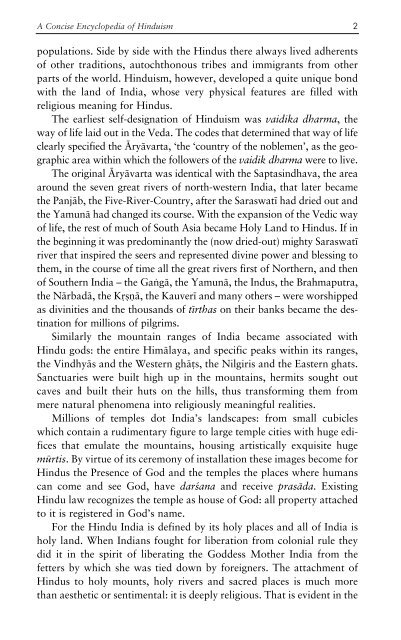A Concise Encyclopedia of Hinduism Klaus K Klostermaie
Create successful ePaper yourself
Turn your PDF publications into a flip-book with our unique Google optimized e-Paper software.
A <strong>Concise</strong> <strong>Encyclopedia</strong> <strong>of</strong> <strong>Hinduism</strong> 2<br />
populations. Side by side with the Hindus there always lived adherents<br />
<strong>of</strong> other traditions, autochthonous tribes and immigrants from other<br />
parts <strong>of</strong> the world. <strong>Hinduism</strong>, however, developed a quite unique bond<br />
with the land <strong>of</strong> India, whose very physical features are filled with<br />
religious meaning for Hindus.<br />
The earliest self-designation <strong>of</strong> <strong>Hinduism</strong> was vaidika dharma, the<br />
way <strong>of</strong> life laid out in the Veda. The codes that determined that way <strong>of</strong> life<br />
clearly specified the Äryävarta, ‘the ‘country <strong>of</strong> the noblemen’, as the geographic<br />
area within which the followers <strong>of</strong> the vaidik dharma were to live.<br />
The original Äryävarta was identical with the Saptasindhava, the area<br />
around the seven great rivers <strong>of</strong> north-western India, that later became<br />
the Panjäb, the Five-River-Country, after the Saraswatï had dried out and<br />
the Yamunä had changed its course. With the expansion <strong>of</strong> the Vedic way<br />
<strong>of</strong> life, the rest <strong>of</strong> much <strong>of</strong> South Asia became Holy Land to Hindus. If in<br />
the beginning it was predominantly the (now dried-out) mighty Saraswatï<br />
river that inspired the seers and represented divine power and blessing to<br />
them, in the course <strong>of</strong> time all the great rivers first <strong>of</strong> Northern, and then<br />
<strong>of</strong> Southern India – the Gaögä, the Yamunä, the Indus, the Brahmaputra,<br />
the Närbadä, the Kø•æä, the Kauverï and many others – were worshipped<br />
as divinities and the thousands <strong>of</strong> tïrthas on their banks became the destination<br />
for millions <strong>of</strong> pilgrims.<br />
Similarly the mountain ranges <strong>of</strong> India became associated with<br />
Hindu gods: the entire Himälaya, and specific peaks within its ranges,<br />
the Vindhyäs and the Western ghäfls, the Nilgiris and the Eastern ghats.<br />
Sanctuaries were built high up in the mountains, hermits sought out<br />
caves and built their huts on the hills, thus transforming them from<br />
mere natural phenomena into religiously meaningful realities.<br />
Millions <strong>of</strong> temples dot India’s landscapes: from small cubicles<br />
which contain a rudimentary figure to large temple cities with huge edifices<br />
that emulate the mountains, housing artistically exquisite huge<br />
mürtis. By virtue <strong>of</strong> its ceremony <strong>of</strong> installation these images become for<br />
Hindus the Presence <strong>of</strong> God and the temples the places where humans<br />
can come and see God, have darÿana and receive prasäda. Existing<br />
Hindu law recognizes the temple as house <strong>of</strong> God: all property attached<br />
to it is registered in God’s name.<br />
For the Hindu India is defined by its holy places and all <strong>of</strong> India is<br />
holy land. When Indians fought for liberation from colonial rule they<br />
did it in the spirit <strong>of</strong> liberating the Goddess Mother India from the<br />
fetters by which she was tied down by foreigners. The attachment <strong>of</strong><br />
Hindus to holy mounts, holy rivers and sacred places is much more<br />
than aesthetic or sentimental: it is deeply religious. That is evident in the


















